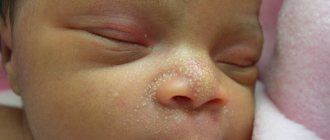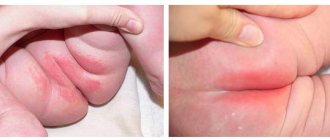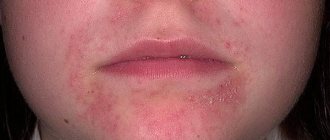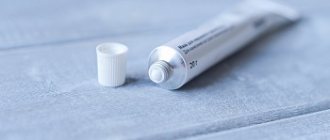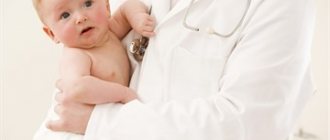Last updated: July 24, 2020
Allergic rashes in children are a very common and common occurrence. Most often, this disease manifests itself in the form of a rash, but the causes can be different. You will learn in this article how allergic rashes in children are treated and what they are like.
- For what reason does an allergic rash appear on a child's skin?
- What does a child's skin allergy look like?
- How to diagnose allergies?
- First aid and treatment
- What is done to prevent allergic rashes in children?
- Types of allergic reactions with photos
- Conclusion
Causes
Allergic rashes can occur in children from birth until the age of 7 years. This is explained by the fact that the immune system has not yet been formed. Below are the main causes of allergic reactions in children:
- Medicines, the body may react negatively to some components of medicines;
- Breast milk if the diet is not followed;
- Hygiene products and household chemicals;
- Plants and animals can also cause rashes;
- Ultra-violet rays;
- Various infections and diseases.
What is hay fever and why does it occur?
Hay fever is the most common type of allergy and is an allergic reaction to pollen in the air and environment. Children with seasonal allergies exhibit symptoms at certain times of the year when certain allergy triggers (such as grass or tree pollen) are circulating. However, some children and adults may be allergic to more than one pollen or trigger, causing symptoms to appear at different times throughout the year. Most children with hay fever experience a noticeable change in symptoms around the same time each year, which is during the flowering season.
Seasonal allergies typically first appear after preschool age, although they can develop at any time during childhood, usually before age 10. Allergy symptoms typically change with age, peaking in your 20s, and then often disappear as you get older. Allergies are usually inherited. If one parent has allergies, there is a 25% chance that the child will also have allergies. And if a child is lucky enough to have both parents with allergies, the risk of developing allergies increases to more than 60%.
What do allergic rashes look like?
There are a large number of types of allergy rashes in children, it all depends on the irritant that caused it. In many cases, exanthemas appear on the child’s body (this is the name given to various manifestations of allergic rashes):
- pustules (filled with pus);
- plaques;
- spots;
- vesicles (filled with liquid);
- blisters (large vesicles larger than 0.5 cm).
With food allergies in children, the rash can be found primarily on the cheeks and near the mouth. With a contact allergy, a rash or irritation will appear in the area where the allergen touched. If the child’s body reacts negatively to medications, inflammation will appear in the area of the lymph nodes.
Cross-reactions with other foods
Children with allergies to the following foods may react to other foods:
Cow's milk allergy: 90% also react to goat's milk and 40% to soy milk.
Egg: in 5% there is a reaction to chicken meat
Peanuts: In 5% of cases there is a reaction to other legumes (such as peas or beans). In 30% there is hypersensitivity to tree nuts.
Fish: in 10% a reaction to seafood is also observed.
Melon: 90% reacts to bananas and avocados
Ragweed pollen allergies can cause a cross-reaction with all melons, bananas and tomatoes.
Birch pollen allergies can cross-react with raw potatoes, carrots, celery and apples.
Grass pollen allergies may cross-react with tomatoes and kiwis.
How to diagnose allergies?
An allergic rash in children is often confused with an infectious one. If the treatment is incorrect, then the consequences of such a therapeutic course will not be the best. Before choosing an effective remedy, you need to learn to distinguish one disease from another. Only a doctor can make an accurate diagnosis, since a visual examination is not always enough to determine the cause of the disease; tests are required.
| Features | Allergic rash | Infection |
| General form | It can be in the form of both small dots and large blisters. In addition to them, there are often crusts, erosions and serous wells (ulcers from which fluid oozes). | The rashes are pinpoint and do not “merge” into a large spot. |
| Place of appearance | Face (forehead, cheeks, chin). Neck, arms, legs, buttocks. Rarely – stomach, back. | Belly, back. Rarely – arms, legs. Very rarely - forehead. |
| Heat | The temperature is rare, and if it rises, it is not higher than 37-38°C. | The disease is accompanied by fever, from 37°C to 41°C. |
| Itching | Happens. | Happens. |
| Swelling | Well visible. In some situations it is life-threatening. | They happen very rarely. |
| Associated symptoms | Lacrimation, conjunctivitis, hyperemia of the mucous membrane of the eye, decreased blood pressure, cough, upset stomach. | Running nose, general loss of strength, body aches. |
| How quickly it goes | Often the rash goes away immediately after taking the medicine. | Remains until the course of treatment is completed. |
Diaper rash
Diaper rash, or diaper rash, is a reddish rash that appears on your baby's skin under and around the diaper. The structure can be either flat or convex. Can cause significant discomfort to the baby. Diaper rash can occur if your baby spends too much time in a wet diaper or if the diaper is too small. If the cause of diaper rash is eliminated, it usually goes away in three to four days. Therefore, try to change your baby's diaper as often as possible. Clean the area under the diaper with wet wipes or a cloth soaked in water and, if possible, give your baby air baths. It is also recommended to use diaper rash cream to create a protective barrier on the skin.
Atopic dermatitis
Atopic dermatitis (or itchy rash) sometimes appears in babies after the first month of life. You may notice your baby's cheeks are red and there are red, dry, flaky patches of skin on the elbow or behind the knees. In infants, atopic dermatitis appears more often on the body than on the face. The rash can be mild, but can also be accompanied by severe itching and cause great discomfort to the baby. If you suspect your baby has atopic dermatitis, consult your pediatrician - he will be able to prescribe an ointment or cream for treatment and care. To get rid of this unpleasant condition or prevent its recurrence, use mild, unscented soap to care for your baby, choose clothes made of soft fabric, and bathe your baby no more than three times a week. To wash children's clothes, use unscented products.
First aid and treatment
If children develop an allergic rash on their skin, it is strictly forbidden to squeeze pimples or open blisters. It is necessary to explain to the child that it is also forbidden to scratch the sores.
If he is still too small, make sure that he does not touch the wounds with dirty hands. He can get an infection, and this will only worsen his condition.
Treatment of rashes in children is selected depending on the type of disease. Parents who do not know how to treat allergic rashes in children should not select medications on their own.
What else do parents need to know?
One in five people suffers from allergies at some point in their lives. Hay fever is the most common type of allergy. It is easily treated by avoiding allergens, washing the child in the shower after returning from outside during flowering season, over-the-counter medications, and sometimes additional prescription medications. Most children with hay fever only need allergy medication during seasonal outbreaks.
Allergy symptoms often change with age. Allergy symptoms can worsen during early childhood and often disappear as people get older.
Drug labels list the ingredients of allergy medications. Use the lowest dose possible to treat symptoms, and check with your child's doctor if he is younger than 6 years old before giving him an over-the-counter antihistamine.
How to avoid allergies in children?
Preventive measures will prevent the child from developing an allergic rash. Doctors give the following recommendations:
- Make sure that the baby does not come into contact with the allergen (remove allergenic foods from his diet; if necessary, change baby powder, soap or dishwashing liquid.
- Maintain order in his room, regularly do wet cleaning.
- If there are pets in the house, keep them clean.
- Strengthen the baby’s immunity (walk more often, play sports).
- Do not violate your doctor’s recommendations for taking medications.
Rashes in a newborn
The sensitive skin of newborns is most susceptible to negative external influences. Among the most common cases of rashes on the body of a baby are:
- Prickly heat. It usually appears in a child due to heat as a result of overheating and difficulty sweating. Most often, this type of rash forms on the head, in particular under the hair, on the face, in the folds of the skin, where diaper rash is present. The rashes are blisters and spots that do not cause discomfort to the child (see also: rough spots on the child's body as a symptom). For diaper rash, the time-tested Panthenol Spray with dexpanthenol, a precursor substance to vitamin B5, is also used, stimulating skin regeneration processes. Unlike analogues, which are cosmetics, this is a certified medicinal product and can be used from the first day of a child’s life. It’s easy to apply – just spray it on the skin without rubbing. PanthenolSpray is produced in the European Union, in compliance with high European quality standards; you can recognize the original PanthenolSpray by the smiley face next to the name on the packaging.
- Acne of newborns. Inflamed papules and pustules affect the face, scalp under the hair and neck. They are a consequence of the activation of the sebaceous glands through maternal hormones. Such acne usually does not need to be treated, but quality care and moisturizing of the skin should be provided. They pass without a trace, leaving no scars or pale spots.
- Toxic erythema. It appears in the form of papules and pustules, having a white-yellow color, with a diameter of 1 to 2 mm, surrounded by a red rim. They appear on the second day of life, then gradually go away on their own.
Heat rash on the face of a baby
Examples of rashes with photos
Colorless rash "goosebumps"
Exudative diathesis
Hives
Food allergies
Scabies
Scabies is a rash caused by microscopic mites that burrow into the skin and lay eggs. After this, the child's scabies rash usually appears within two to four weeks. Scabies occurs in both infants and older children, but it manifests itself in different ways. In infants, it appears as fluid-filled pimples, and the rash usually occurs only on the palms of the hands and soles of the feet. In older children, you may notice small bumps next to reddened areas of the skin - the itch burrows made by the mite. If you suspect your child has scabies, consult a doctor. The specialist will be able to make a scraping to exclude or confirm the disease and, if necessary, prescribe treatment. Because scabies is a contagious dermatological disease, your doctor may recommend treatment for the entire family.
Pyoderma in a child
If you take your baby's hygiene seriously, you can prevent many health problems. This also applies to skin pathologies - dermatitis, which has numerous varieties. The most common form of dermatitis in childhood (especially in the first months of life) is pyoderma.
Pyoderma is a purulent skin disease, which is a group of pathologies that develop against the background of penetration of pyogenic microorganisms into the skin. Parents should take into account the ways of transmission of pyoderma: germs are transmitted when the child comes into contact with sick people or a contaminated object.
The disease is most often diagnosed in childhood and has many types. There is an opinion that the cause of pyoderma lies in poor diet and poor hygiene. Although this is not entirely true. This skin pathology develops under the influence of various pathogens: streptococci, staphylococci, pneumococci, Pseudomonas aeruginosa, E. coli, etc.
Often the human body is the habitat of certain microorganisms, which are activated when protective functions are reduced, which leads to the appearance of their pathogenic qualities.
Since the protective function of newborns and infants is more weakened, pyoderma in such patients occurs in a severe form. This happens if treatment is not started in a timely manner and the baby is not properly cared for. In the body of children under 2 months of age, there is no independent production of antibodies. As a result, it is important to care for the baby’s skin throughout the body.
Types of rash
Rashes on the abdomen of a child are quite variable in nature and etiology (origin).
Pediatricians distinguish the following types of rash:
- Spots are areas with clear boundaries on the surface of the skin of a discolored color (spots do not protrude above the skin and cannot be felt during palpation);
- Papules are tubercles up to 5 mm in diameter, without an internal cavity and protruding above the skin;
- Plaques are formations raised above the surface of the epidermis, significant in area, having a flattened shape;
- Vesicles are formations with liquid contents;
- Bubbles are vesicles more than 5 mm in diameter;
- Pustules are cavities limited by the membrane with purulent contents.
Some diseases are also characterized by peeling of the skin. Any changes in the appearance of the skin surface are a signal that not everything is in order in the baby’s body. Of course, not all diseases accompanied by a rash require special therapy, but such signs should not be ignored in any case.
Allergy on the cheeks: symptoms
Redness of the skin on the cheeks, chin and other parts of the face, the appearance of a rash, mild swelling, dry skin are the most common signs of an allergic reaction.
Among the skin manifestations, itching and flaking should also be noted - symptoms that cause a lot of trouble for the baby. From itching and burning, the child becomes restless and irritable, sleeps poorly, and may lose appetite. In addition, because of the itching, the baby will try to scratch the rash: this should not be allowed, as scratching can cause infection. Then the rashes will begin to fester and recovery will be delayed.
In some cases, allergies are accompanied by difficulty breathing, coughing, sneezing, watery eyes, photophobia, and nasal congestion.
An allergic reaction can affect the scalp: in this case, gray, yellowish or brown scales (gneiss) appear on it.
An allergic reaction can become the initial stage of inflammatory and skin diseases - eczema, dermatitis, conjunctivitis, etc.
Dermatitis in a child and psychosomatics
Skin health directly depends on a person’s mental well-being. Stress changes hormonal levels and metabolism, causing disruptions in the functioning of the immune system. Therefore, a calm emotional state will prevent exacerbation of the disease and delay the first appearance of symptoms.
When faced with contact dermatitis, analyze the causes and identify the allergen that caused it.
It's not always easy. To be sure of the correct diagnosis, conduct the necessary tests and receive treatment, come for a consultation at our center. In addition to treatment, you will learn how to properly prevent this disease. December 3, 2020
Author of the article: dermatologist Mak Vladimir Fedorovich
